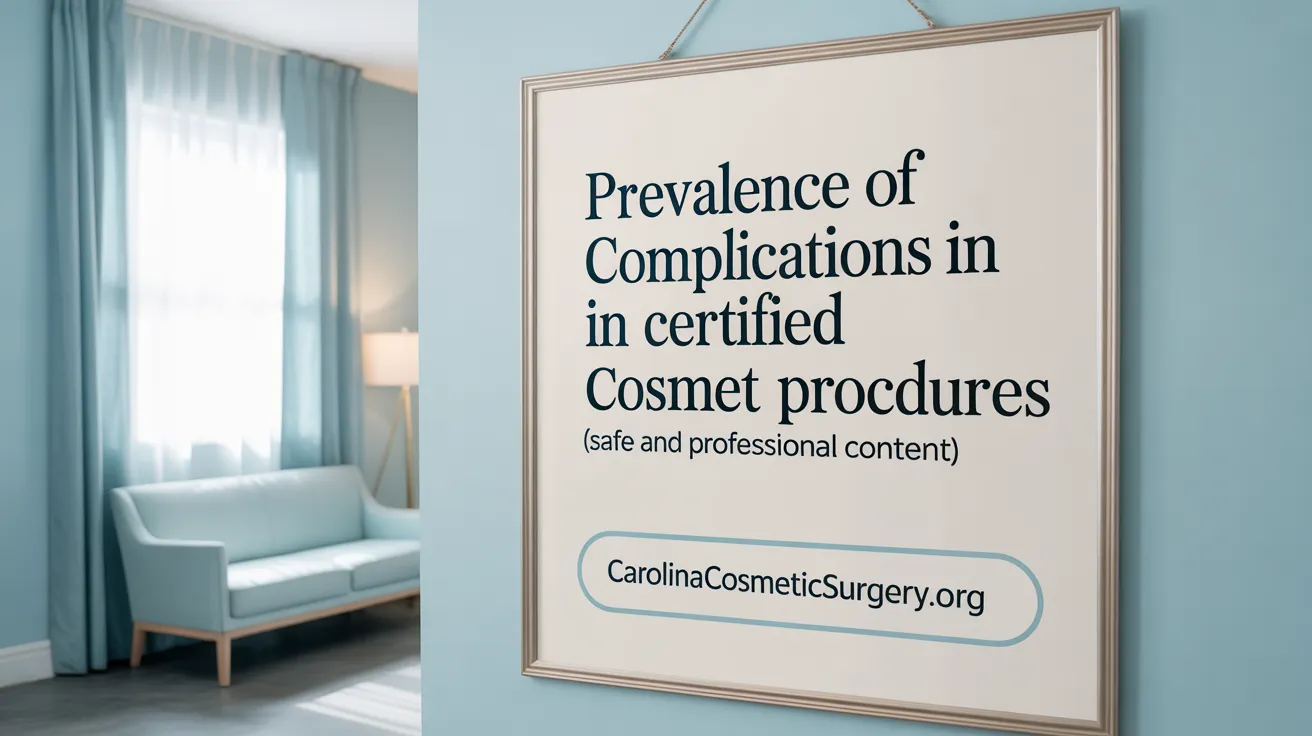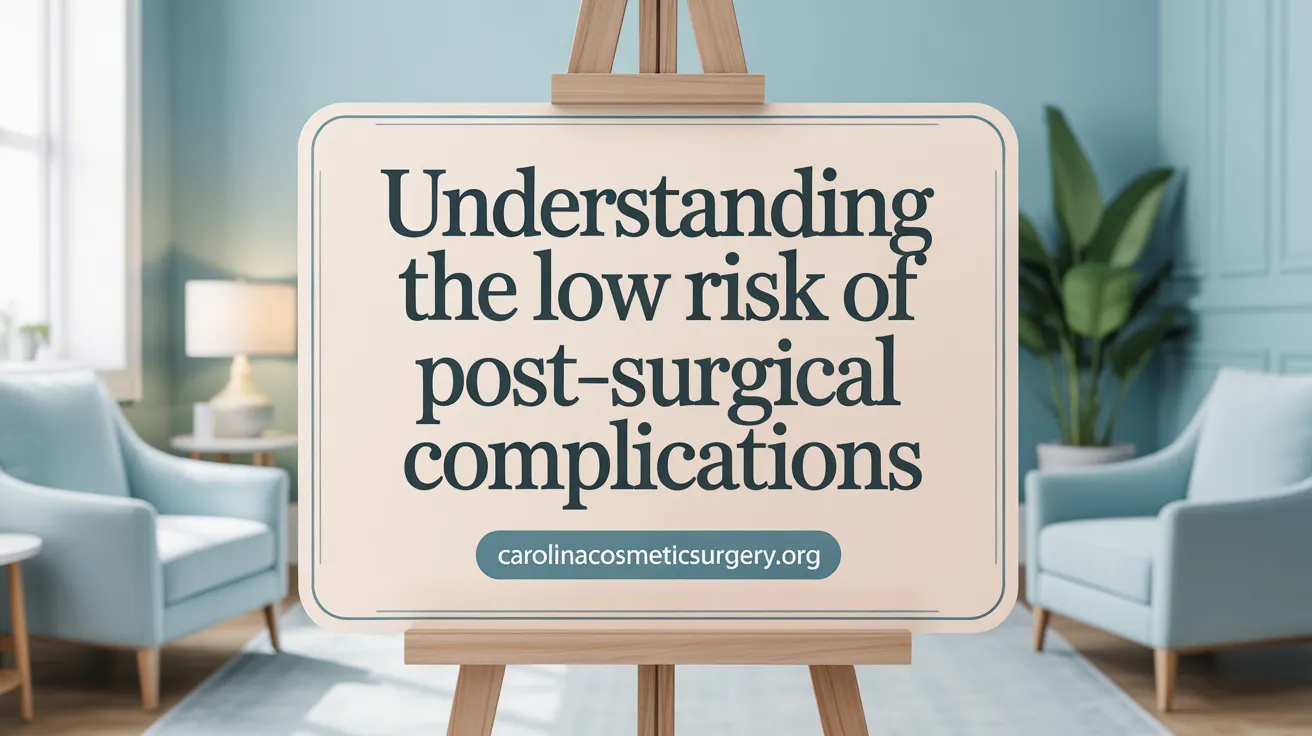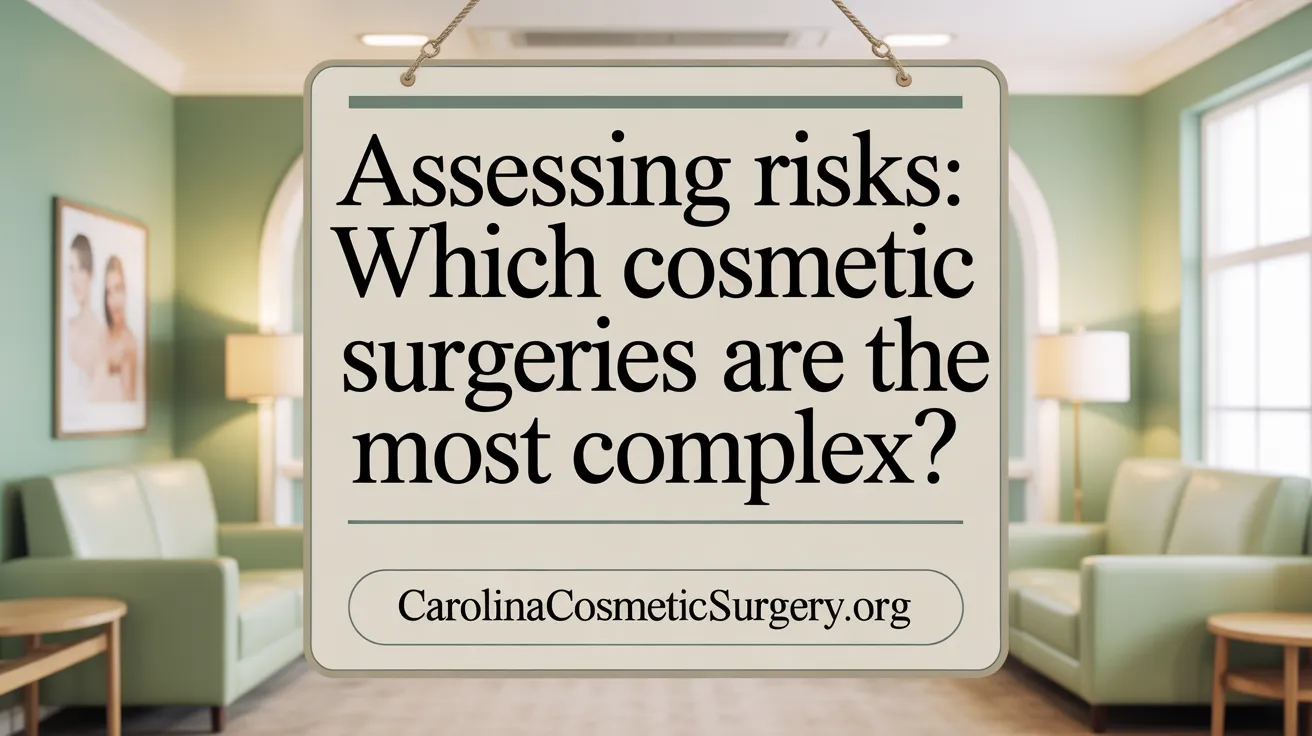Understanding Post-Surgical Complications in Cosmetic Procedures
Cosmetic surgery enjoys rising popularity, with millions of procedures performed annually in the United States alone. While these procedures are commonly safe, understanding the prevalence and nature of post-surgical complications in certified cosmetic centers is essential for prospective patients and healthcare professionals alike. This article delves into complication rates, influencing factors, and protective protocols that define the safety landscape of cosmetic surgery performed in accredited facilities.
<!-- VIDEO:eyJsaW5rIjoiaHR0cHM6Ly93d3cueW91dHViZS5jb20vd2F0Y2g/dj10MUtCSlhXY24tOCIsImltYWdlVXJsIjoiaHR0cHM6Ly9lbmNyeXB0ZWQtdGJuMC5nc3RhdGljLmNvbS9pbWFnZXM/cT10Ym46QU5kOUdjUl9kTV9ydjkxcUIxUXpfQ3NvWmo2X2sxTzF4ck1VOVZrb0QxN0VJQkRramgwQiZzIiwidGl0bGUiOiJUaGUgUmlza3Mgb2YgTGlwb3N1Y3Rpb24gYW5kIEhvdyB0byBBdm9pZCBDb21wbGljYXRpb25zIiwic25pcHBldCI6Ii4uLiBjZXJ0aWZpZWQgcGxhc3RpYyBzdXJnZW9uIGNhbiBtaW5pbWl6ZSB0aG9zZSByaXNrcyBvZiBhIGNvbXBsaWNhdGlvbi4gRHIuIEJ5cm9uIFBvaW5kZXh0ZXIgb2YgdGhlIEF1c3Rpbi1XZXN0b24gQ2VudGVyIGZvciBDb3NtZXRpYyBTdXJnZXJ5IC4uLiJ9 -->Prevalence and Frequency of Post-Surgical Complications in Certified Cosmetic Centers
 The likelihood of experiencing complications after cosmetic surgery is very low when procedures are carried out in accredited centers by qualified surgeons. Most large studies report overall complication rates below 1%. Specifically, within the first 48 hours after outpatient procedures, the complication rate is about 0.98%, indicating that the vast majority of patients experience smooth recoveries.
The likelihood of experiencing complications after cosmetic surgery is very low when procedures are carried out in accredited centers by qualified surgeons. Most large studies report overall complication rates below 1%. Specifically, within the first 48 hours after outpatient procedures, the complication rate is about 0.98%, indicating that the vast majority of patients experience smooth recoveries.
Among the various complications, minor issues such as infections and wound dehiscence are most frequently observed. Infections account for approximately 32.5% of complications, while wound separation occurs in about 22.5% of cases. Serious events like hematomas, which often require additional surgery, are quite rare—occurring in roughly less than 1% of procedures.
Large-scale data over 20 years involving over 26,000 cases shows the safety of outpatient aesthetic surgery, provided the procedures are performed in proper facilities. Major complications like infections are extremely uncommon, limited to about 0.46% of cases across extensive studies involving over 129,000 patients.
Factors such as higher body mass index, longer surgery durations, larger liposuction volumes, and combined procedures can increase the risk slightly. Nonetheless, the overall safety profile remains high, especially when patient selection, preoperative planning, and postoperative care are optimal.
Most complications are minor, and serious adverse outcomes like death are very rare. Proper care, surgical expertise, and adherence to safety standards in accredited centers contribute significantly to minimizing these risks, ensuring that cosmetic surgeries continue to be safe procedures with excellent outcomes.
Statistical Insights: How Often Do Complications Arise?

What percentage of plastic surgeries result in complications?
The risk of experiencing complications after cosmetic procedures is relatively low. Studies involving over 129,000 patients across various procedures report an overall major complication rate of approximately 0.46%. For outpatient surgeries specifically, the complication rate within 48 hours is about 0.98%. This figure includes minor issues like hematomas, which are the most common and often require surgical intervention.
Most complications are minor and manageable, with hematomas accounting for over 80% of surgical revisions due to bleeding or blood vessel injury. Serious outcomes such as infections are rare, occurring at rates around 0.06%, and fatality is extremely uncommon.
Importantly, the risk increases slightly with complex or combined procedures, longer operative times, and patient-related factors like obesity or smoking. For example, the risk of surgical site infection doubles with higher body mass index (BMI) and can further increase when multiple surgeries are performed simultaneously.
Overall, the data demonstrate that cosmetic surgery is safe, especially when performed by qualified, board-certified surgeons in accredited facilities. Patients should be aware that while the risk of serious complications is low, careful preoperative planning and postoperative monitoring can further reduce adverse outcomes.
Types of complications requiring surgical intervention
Most complications needing surgical management are minor issues such as hematomas, which comprise over 80% of post-surgical surgical revisions. Seromas, or fluid accumulations, are common after procedures like tummy tucks, with an incidence of up to 30%. Wound infections, though rare, can also necessitate surgical debridement.
More severe complications, such as deep infections or organ damage, are much less frequent but impactful. For instance, deep vein thrombosis and pulmonary embolism occur in less than 0.1% of patients. Infections requiring re-operation happen at a rate of approximately 0.3% for single procedures, but this rises to 0.8% when multiple procedures are combined, mainly due to extended operative periods.
Certain procedures carry specific risks. The Brazilian butt lift (BBL) has the highest risk of fatal fat embolism, emphasizing the importance of proper technique and patient counseling.
Role of insurance and patient demographics in complication management
Insurance coverage influences the management of surgical complications. Most patients requiring post-complication care are covered by Medicaid (55%), followed by those with commercial insurance (30%). A smaller percentage is covered by Medicare or are uninsured.
Demographics indicate a female preponderance, especially among those involved in cosmetic tourism, with 98.1% being women. The most common surgical destination for treatment abroad is the Dominican Republic, which accounts for over 82% of cosmetic tourism cases.
Patients with higher BMI, older age, and comorbidities like diabetes or smoking history are at increased risk for complications and often require more intensive postoperative monitoring and care.
| Aspect | Statistic | Additional Notes |
|---|---|---|
| Surgery complications | 0.98% (outpatient procedures) | Mostly minor, hematomas common |
| Major complications | 0.46% | Includes serious infections and organ damage |
| Infection rate | 0.06% | Rare but serious when occurring |
| Blood clot risk | 0.09% | Slightly higher with multiple procedures |
| Uninsured patients | 7.5% | May impact access to follow-up care |
| Female patients in tourism | 98.1% | Predominant demographic involved in travel-related care |
This data underscores the overall safety of modern cosmetic surgery while highlighting the importance of patient selection, surgical expertise, and post-op care in minimizing risks.
Key Factors Influencing Post-Surgical Complications in Accredited Facilities
 When considering cosmetic surgery in reputable centers, several factors can influence the likelihood of post-surgical complications. Patient health and demographic factors are significant; older age, obesity, diabetes, and smoking have all been associated with higher risks. For example, obesity markedly increases the chance of infections and wound healing problems, with infection rates doubling as BMI rises.
When considering cosmetic surgery in reputable centers, several factors can influence the likelihood of post-surgical complications. Patient health and demographic factors are significant; older age, obesity, diabetes, and smoking have all been associated with higher risks. For example, obesity markedly increases the chance of infections and wound healing problems, with infection rates doubling as BMI rises.
Surgical procedure complexity and duration are also crucial. Studies show that surgeries lasting longer than four hours or involving multiple combined procedures tend to have increased complication rates. Longer operative times place more stress on the body and elevate risks such as blood clots or bleeding.
The impact of combining procedures is noteworthy. Performing multiple surgeries simultaneously can increase the overall stress and risk of complications like seromas, hematomas, or infections. Careful patient selection and surgical planning are necessary to minimize these risks.
Surgeon expertise and facility accreditation play vital roles in safety. Board-certified plastic surgeons operating in accredited surgical centers follow strict safety protocols, reducing the incidence and severity of complications. Outpatient procedures at these centers tend to have lower complication rates compared to hospital-based surgeries, especially for minor procedures under local anesthesia.
Effective communication, thorough preoperative assessments, and postoperative care are key systemic factors. Proper patient education about post-surgical instructions and follow-up appointments help prevent complications such as infections or wound dehiscence. Additionally, systemic safety measures like prophylactic antibiotics and vigilant monitoring further contribute to positive outcomes.
In summary, a combination of patient-specific factors, procedure complexity, surgeon experience, and facility standards collectively influence post-surgical complication risks. Choosing accredited centers and qualified surgeons, along with optimizing patient health before surgery, are fundamental steps to ensure safety and successful results.
Safety Protocols and Best Practices to Minimize Risks
 Ensuring patient safety in cosmetic surgery involves several vital protocols and guidelines. A primary step is choosing procedures performed in accredited facilities. These centers, recognized by organizations such as the American Association for Accreditation of Ambulatory Surgery Facilities (AAAASF), Joint Commission International (JCI), or the Joint Commission on Accreditation of Healthcare Organizations (JCAHO), adhere to strict standards for cleanliness, equipment, and safety practices. Such accreditation signifies compliance with rigorous quality benchmarks, significantly reducing the risk of complications.
Ensuring patient safety in cosmetic surgery involves several vital protocols and guidelines. A primary step is choosing procedures performed in accredited facilities. These centers, recognized by organizations such as the American Association for Accreditation of Ambulatory Surgery Facilities (AAAASF), Joint Commission International (JCI), or the Joint Commission on Accreditation of Healthcare Organizations (JCAHO), adhere to strict standards for cleanliness, equipment, and safety practices. Such accreditation signifies compliance with rigorous quality benchmarks, significantly reducing the risk of complications.
The importance of selecting a board-certified surgeon cannot be overstated. Surgeons certified by reputable entities like the American Board of Plastic Surgery demonstrate extensive training in surgical techniques, safety procedures, and ethical standards. They typically hold hospital privileges and operate in facilities with appropriate safety measures, ensuring a high standard of care.
Preoperative and postoperative care are critical components of safety. Comprehensive preoperative evaluations identify patient-specific risks, such as obesity, smoking, or comorbidities like diabetes, that might increase complication rates. Patients are thoroughly informed about potential risks during the consent process, and individualized treatment plans are developed to mitigate these risks.
Infection control and anesthetic precautions form another cornerstone of safety. Strict aseptic techniques, proper sterilization of instruments, and adherence to infection prevention guidelines help Minimize postoperative infections, which are among the most common complications. During surgery, vigilant anesthesia monitoring — including continuous vital signs and oxygenation checks — is essential to prevent anesthetic-related issues such as breathing problems or cardiovascular complications.
Postoperative monitoring, especially for high-risk patients, enhances early detection and management of complications. Regular follow-up appointments allow surgeons to observe wound healing, identify signs of infection or hematoma early, and intervene promptly. Clear postoperative instructions on activity restrictions, wound care, and signs of complication further support optimal recovery.
Implementing best practices in safety protocols, from rigorous facility standards to diligent patient monitoring, remains essential to maintaining low complication rates and achieving successful aesthetic outcomes.
Complexity and Risk Profiles of Cosmetic Procedures

Which cosmetic surgery procedures are considered the most complex?
Rhinoplasty stands out as one of the most intricate cosmetic surgeries. It requires a precise balance of artistic skill and scientific knowledge to reshape the nose in a way that looks natural and functions properly. Surgeons must carefully modify nasal bones, cartilage, and tissues, which demands high technical expertise.
This procedure's complexity is increased because it not only alters facial appearance but can also improve breathing and facial harmony. It can even influence voice resonance, adding layers of consideration for the surgeon. Achieving the desired outcome involves meticulous planning and execution to minimize risks such as breathing difficulties or asymmetry.
Other procedures, like abdominoplasty (tummy tuck), also have notable risk profiles, especially when combined with techniques like liposuction. Such combined procedures extend operative times and increase stress on the body, which can raise the chance of complications such as infections or wound healing issues.
Patients' overall health significantly impacts the complexity of their surgeries. Conditions like obesity, diabetes, or smoking habits can lead to higher risks of infection and poor healing. Therefore, thorough preoperative assessment and patient optimization are vital.
| Procedure | Risk Level | Why It Is Complex | Additional Notes |
|---|---|---|---|
| Rhinoplasty | High | Reshaping nasal structures while maintaining function | Often requires experience in both aesthetic and functional outcomes |
| Abdominoplasty | Moderate to High | Managing large tissue removal, wound care, and potential blood loss | Longer surgery increases risk, especially in combination with liposuction |
| Combined Procedures | Elevated | Extends operative time, increases stress on patient’s body | Needs careful planning to minimize risks |
How does patient health influence the complexity of cosmetic procedures?
Patient health is a crucial factor in determining how complex a cosmetic procedure can be. Conditions such as higher BMI, smoking, diabetes, or previous health issues elevate the likelihood of complications like infections, hematomas, or delayed healing.
For example, obese patients face a doubled risk of surgical site infections and blood clots, such as deep vein thrombosis. Smokers are at increased risk because nicotine constricts blood vessels, impairing healing.
Preoperative assessments and optimizing health—like quitting smoking and managing medical conditions—are essential steps to reduce risks. Additionally, careful patient selection helps ensure that only those with manageable risk profiles undergo complex surgeries, ultimately contributing to safer outcomes.
| Risk Factor | Impact on Surgery | Effect on Management |
|---|---|---|
| Higher BMI | Increased infection and blood clots | May require closer monitoring and preventive care |
| Smoking | Impaired healing, increased infection risk | Quitting before surgery reduces complication rates |
| Diabetes | Slower wound healing | Tight glucose control is recommended |
| Combined procedures | Longer operation time, higher stress | Surgeons may opt for staged procedures |
This highlights that achieving safe, effective results depends heavily on preoperative health optimization and tailored surgical planning.
Ensuring Safety in Cosmetic Surgery: Key Takeaways
Post-surgical complications in certified cosmetic centers are uncommon, thanks to the high standards maintained by board-certified surgeons and accredited facilities. While the overall complication rate remains below 1%, understanding the factors increasing risk, such as patient health and procedural complexity, helps tailor safer surgical experiences. Adhering to rigorous safety protocols—from preoperative assessment through postoperative care—plays a critical role in minimizing adverse events. Prospective patients should prioritize choosing accredited centers and qualified surgeons and adhere scrupulously to medical advice to maximize the safety and success of their aesthetic procedures. Ongoing research and comprehensive databases continue to enhance the understanding and management of complication risks, fortifying the trusted reputation of cosmetic surgery when performed responsibly.
References
- Management of Plastic Surgery Complications at a Tertiary Medical ...
- Study Supports Safety of Outpatient Plastic Surgery Procedures
- Certain risk factors linked to post-surgery infection - VUMC News
- NEWSROOM - CosmetAssure
- 3 Tips for Avoiding Complications and Optimizing Plastic Surgery ...
- Complications of Aesthetic Surgical Tourism Treated in the USA
- Review Infective complications of cosmetic tourism: A systematic ...
- 10 of the Most Common Plastic Surgery Complications - Healthline
